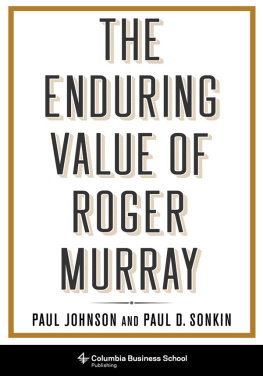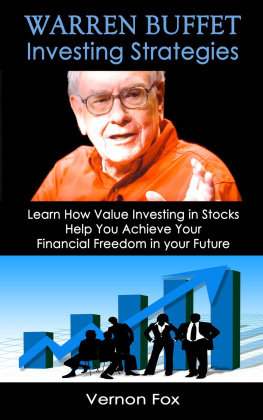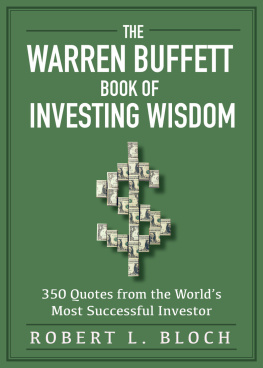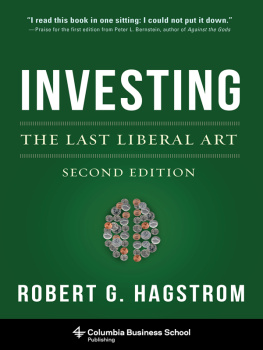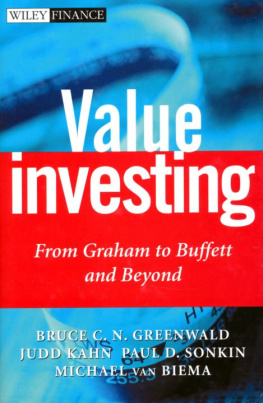BRUCE C. N. GREENWALD JUDD KAHN PAUL D. SONKIN MICHAEL VAN BIEMA




For Virginia Greenwald who now only need find a ship and Anne Rogin who need not
PART I AN INTRODUCTION TO VALUE INVESTING
PART II THREE SOURCES OF VALUE
PART III VALUE INVESTING IN PRACTICE: PROFILES OF EIGHT VALUE INVESTORS

Benjamin Graham is commonly credited with establishing security analysis as a reasonably firm discipline within an investment world that had been dominated by speculation, insider information, and other practices at best unsound and at worst downright shady. The publication of Security Analysis with David Dodd in 1934 marks the start of a profession. Graham made his ideas and techniques more available to professionals and interested amateurs with The Intelligent Investor, which initially appeared in 1949. Each book has been revised several times. Security Analysis is available both in its initial, classic version and in a fifth edition that purists feel has little of Graham remaining. The New York Society of Security Analysts, an association Graham founded, contends that he "is to investing what Euclid is to geometry, and Darwin is to the study of evolution." Though this may carry the praise further than Graham himself would have allowed, his significance to investing is not in dispute.
Graham did more than put investing on a rational foundation. He also engraved on the minds of his students and devotees a strong preference for what would now be called value investing. To present the most succinct description, the value investor seeks to purchase a security at a bargain price, the proverbial dollar for 50 cents. There is considerably more to it than that, as this book attests. Still, despite all the changes in the investment world since the 1920s, Graham initiated an approach to investing that remains vital today. Our effort here is to build on his work and on that of his successors and to incorporate the advances in value investing that have appeared over the last three or four decades.
Starting in 1928, Graham began to teach a course on security analysis at Columbia University, his alma mater. The book he wrote with Dodd grew from that course. The course at Columbia lasted through several incarnations after Graham and Dodd and passed eventually into the hands of Roger Murray, an author of the fifth edition of Security Analysis. On Murray's retirement in 1978, the course and the tradition disappeared from the formal academic curriculum. Outside the university, the intellectual life of value investing remained robust in the world of practicing investors, thanks primarily to Warren Buffett, who had taken the original Graham and Dodd course in 1950 after having been exposed to The Intelligent Investor. He read the first edition of Security Analysis while on his honeymoon. Together with a number of other Graham students, Walter Schloss among them, Buffett established records of consistent investment success that attracted continuing attention to value investing.
Further generations of former students, including Mario Gabelli, who had taken the course with Roger Murray, continued to refine and extend the basic value approach. In 1992 Gabelli prevailed on Murray to offer a series of lectures on value investing to Gabelli's own analysts, who had found nothing like it in their formal MBA courses. As the newly appointed Heilbrunn Professor of Asset Management and Finance, I attended those lectures out of curiosity. Like generations of investors who preceded me, I was struck by the compelling logic of Graham's approach. As a consequence, in 1993 I dragooned Roger Murray into joining me in offering a revived and revised version of the value course. That course, which continues to attract large numbers of both MBA and professional-level students, is the point of departure for this book.
Meanwhile, in the 1950s and 1960s a new approach to investment analysis emerged from scholars who had been trained in economics or statistics. As a group they produced a body of work, sometimes called modern investment theory, that, if accurate, has several inescapable implications for investors:
The market is efficient, and it is not possible to outdo its returns except by accident.
Risk is measured by the contribution of individual securities to the volatility of returns of widely diversified portfolios, rather than the more common-sense understanding of risk as permanent loss of capital.
The best strategy for investors is to buy a broad index of securities and adjust for the desired level of risk by combining investments in this index portfolio with greater or lesser amounts of a risk-free asset, such as cash.
There were always investment professionals who disagreed with this theory, especially as their livelihood depended on its being incorrect or at least difficult for their clients to swallow. But over the last 20 years, a number of academic studies began to challenge the efficiency hypothesis. In these studies, mechanical variants of value investing (e.g., low price to earnings, low price to book value) have bested the indexes, as have some variants of momentum investing (e.g., buy stocks that have gone up and sell them before they go down). The general outcome has been to tarnish if not destroy the efficient market orthodoxy and to reinforce the worth of Graham's approach.
Along with the purely statistical challenges to modern investment theory, a body of work labeled behavioral finance has built on psychological research to dispute the idea that investors act as dispassionate calculating machines. It turns out that like everyone else, investors respond to events in the world with certain powerful biases. New information is interpreted, not simply digested, and not all of that interpretation is rational. One powerful set of biases tends to give more significance to the most recent news, good or bad, than is actually warranted. The stocks of companies that report high rates of growth are driven to extremes, as are stocks of companies that disappoint. These findings about excessive reactions confirm a belief that value investors have held since Graham: Over the long run, performance of both companies and share prices generally reverts to a mean. The first edition of Security Analysis had as a frontispiece this quote from Horace's Ars Poetica: "Many shall be restored that now are fallen and many shall fall that now are in honor." If value investors have their own bias, Horace captured it. Again, modem academic research has moved the theory of financial market behavior in the direction of Graham and Dodd.
More surprisingly, Graham and Dodd's insights into the methods of valuing companies have also anticipated recent developments in the field. At the core of most investment approaches lies the practice of valuation, the techniques by which the real or intrinsic value of a company can be estimated. Most investors want to buy securities whose true worth is not reflected in the current market price of the shares. There is general agreement that the value of a company is the sum of the cash flows it will produce for investors over the life of the company, discounted back to the present. In many cases, however, this approach depends on estimating cash flows far into the future, well beyond the horizon of even the most prophetic analyst. Value investors since Graham have always preferred a bird in the hand-cash in the bank or some close equivalent-to the rosiest projection of future riches. Therefore, instead of relying on techniques that must make assumptions about events and conditions far into the future, value investors prefer to estimate the intrinsic value of a company by looking first at the assets and then at the current earnings power of a company. Only in exceptional cases are they willing to factor in the value of potential growth.



